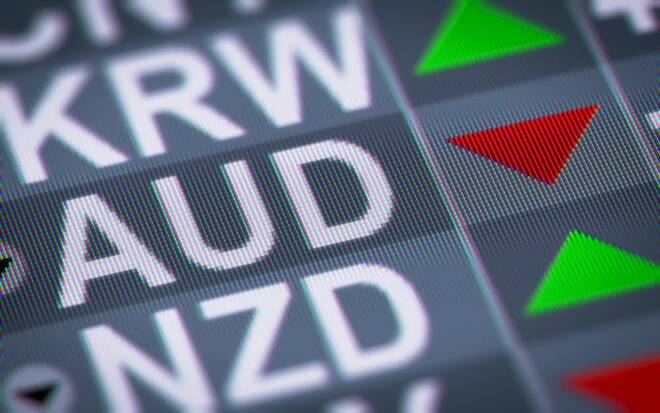Advertisement
Advertisement
AUD/USD and NZD/USD Fundamental Daily Forecast – Mixed Trade as Caution Reigns Ahead of US Inflation Data
By:
The Australian and New Zealand Dollars showed little reaction to China’s inflation news with most of the focus on the U.S. inflation data.
In this article:
The Australian and New Zealand Dollars are trading nearly flat early Wednesday ahead of a key U.S. consumer inflation report that could have a major influence on Fed policy and future interest rate moves.
Traders are also reacting to inflation data from China that came in below expectations. There were no major releases from Australia and New Zealand, following mixed Aussie news the previous session.
At 04:02 GMT, the AUD/USD is trading .6959, down 0.0004 or -0.05% and the NZD/USD is at .6292, up 0.0005 or +0.09%. On Tuesday, the Invesco CurrencyShares Australian Dollar Trust ETF (FXA) settled at $69.15, up $0.04 or +0.05%.
Australian Business Confidence Improves, Consumer Sentiment Falls
Australia’s business confidence improved strongly in July despite inflation and rising interest rates clouding the outlook, survey results from NAB showed on Tuesday.
The NAB Business Confidence Index rose to +7 in July from +2 in June.
With businesses running at close to full capacity and unemployment at 3.5%, materials and labor are becoming ever-more expensive, driving prices higher, NAB Group Chief Economist Alan Oster said.
“That cycle is likely to continue until demand starts to soften more materially, which we expect to occur over the coming months as higher interest rates begin to weigh on household budgets,” added Oster.
While Australian business confidence was improving, consumer confidence was deteriorating. Sentiment among Australian consumers worsened further in August amid surging inflation and interest rate hikes, survey data from Westpac showed Tuesday.
The Westpac-Melbourne Institute Index of Consumer Sentiment fell 3.0% to 81.2 in August from 83.8 in July.
The strength in business confidence greenlights another rate hike from the Reserve Bank (RBA), but the market isn’t sure if it will be 50 or 75 basis points. Meanwhile, consumers should be prepared to feel more main.
China Inflation: Consumer Prices Edge Up to 2 Year High, Producer Prices Ease
China’s consumer inflation edged up last month to the highest level in two years, data released on Wednesday showed, but producer prices continued to ease.
The consumer price index (CPI) rose by 2.7% in July from a year earlier, up from 2.5% in June, the National Bureau of Statistics (NBS) said. This was the strongest growth since also reaching 2.7% in July 2020. The reading was below expectations, however.
In other news, China’s producer price index (PPI), which reflects the prices that factories charge wholesalers for products, rose by 4.2% in July, down from a rise of 6.1% in June.
The Australian and New Zealand Dollars showed little reaction to China’s inflation news with most of the focus on the U.S. inflation data. Nonetheless, the PPI looks like its peaking, which will eventually drive down China’s CPI.
Daily Forecast
Today’s key U.S. report is expected to show inflation may finally be cooling, thanks to falling gasoline prices and fading chain issues. This means the surprise will be to the upside.
Economists expect July’s consumer price index rose 0.2%, down from 1.3% in June, according to Dow Jones. Year-over-year, the pace of consumer inflation in July is expected to fall to 8.7%, down from June’s 9.1%.
Excluding energy and food, CPI is expected to rise by 0.5% in July as rents and services prices rose, but that is down from 0.7% in June. Core CPI is still expected to be higher than June on a year-over-year basis, gaining 6.1% from June’s 5.9%.
In my opinion, if the report comes in as expected then look for the market to continue to press for a 75 basis-point rate hike from the Fed in September. This should put pressure on the AUD/USD.
Another jump in CPI and Core CPI will increase the odds of a 75 to 100 basis-point rate hike, which again would put downside risk on the AUD/USD.
The only way I see the AUD/USD garnering any strength is if both the CPI and Core CPI come in lower than expectations. This could drop the odds of a 75 basis-point rate hike by the Fed and increase the chances of a 50 basis-point rise.
For a look at all of today’s economic events, check out our economic calendar.
About the Author
James Hyerczykauthor
James is a Florida-based technical analyst, market researcher, educator and trader with 35+ years of experience. He is an expert in the area of patterns, price and time analysis as it applies to futures, Forex, and stocks.
Did you find this article useful?
Latest news and analysis
Advertisement
